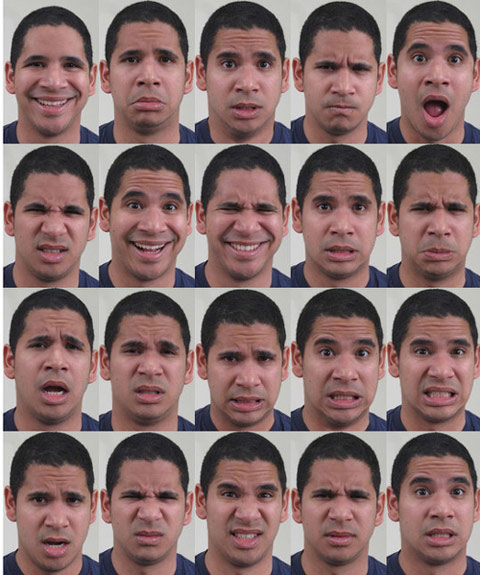|
查看原文
When you're feeling one of those combination emotions, like sadly angry or happily disgusted, it shows on your face in a unique way, a new study shows.
In fact, there may be at least three times more recognizable human facial expressions than previously thought, the researchers said.
In a new study, researchers defined 21 facial expressions that we use to convey our emotions, and found that a computer model could tell them apart with a high degree of accuracy by looking for small changes in facial muscles.
Among these facial expressions were the six, long-recognized basic emotions — happy, sad, fearful, angry, surprised and disgusted — but also 15 others, which were a combination of these basic feelings. For example, a person may show that they feel happily surprised, or angrily surprised, said the researchers, calling such feelings compound emotions.
This extended library of facial expressions of emotions may be useful in studying human brain and social communication, as well as in the design of computer systems that can communicate with humans, researchers said in their study published today (March 31) in the journal Proceedings of the National Academy of Sciences.
"We've gone beyond facial expressions for simple emotions like 'happy' or 'sad.' We found a strong consistency in how people move their facial muscles to express 21 categories of emotions," said study researcher Aleix Martinez, a cognitive scientist and associate professor of electrical and computer engineering at The Ohio State University. "That tells us that these 21 emotions are expressed in the same way by nearly everyone, at least in our culture."
Historically, scientists and philosophers have focused their studies on six basic emotions, but deciphering a person's brain functioning with only six categories is like painting a portrait with only primary colors, Martinez said in a statement.
In the study, the researchers took about 5,000 photographs of 230 college students who were asked to make faces in response to verbal cues such as, "You just got some great, unexpected news" (happily surprised) or "You smell a bad odor" (disgusted).
To determine which expressions were unique enough to be consistently distinguished from others, the researchers analyzed the photographs with a computer program called the Facial Action Coding System (FACS). Popularized by psychologists in the 1970s, FACS breaks a facial expression down into its elements, such as raised eyebrows or wrinkled nose, and analyzes the underlying muscle movements that are used to create that expression.
The FACS analysis revealed that the 21 expressions used a unique combination of muscles that was different from all other expressions. A computational model of face perception identified the six basic expressions with 96.9 percent accuracy, and the 15 compound expressions with 76.9 percent accuracy.
Some expressions were more consistently recognizable than others, the researchers said. For example, 99 percent of the time study participants used the same muscle movements to express happy, whereas for compound emotions, such as happily surprised, the participants expressed it the same way 93 percent of the time.
Although the collection of emotional expressions would be of most interest for basic research in cognition, researchers said that it may be also useful for understanding whether perception of compound emotions is altered in psychiatric disorders such as schizophrenia, orsocial impairments such as autism.
|
查看譯文
據(jù)LiveScience網(wǎng)站報(bào)道,當(dāng)人們感受到上述復(fù)合情感時(shí)���,例如悲憤或者又開心又討厭�����,這些情感就會(huì)以一種特別的方式呈現(xiàn)在臉上��。
研究人員表示�,事實(shí)上����,可識(shí)別的人類面部表情的數(shù)量至少是之前所認(rèn)為的三倍之多。
在一項(xiàng)新研究中��,研究人員定義了21種用于傳遞感情的面部表情��,并發(fā)現(xiàn)��,借助某種計(jì)算模型可以區(qū)分面部肌肉的微變化�����,從而準(zhǔn)確分辨這些表情。
這些表情中���,最早為人所知的六種基本情感分別是����,喜悅��、悲傷�����、害怕��、憤怒�����、和厭惡�。另外15種則是這些基本情感的組合。例如��,某人可能表現(xiàn)出驚喜��,或者驚怒。研究人員將其統(tǒng)稱為復(fù)合情感���。
3月31日發(fā)表在美國(guó)國(guó)家科學(xué)院院刊上的報(bào)告顯示����,對(duì)情感投射的面部表情進(jìn)行這樣的詞匯擴(kuò)充����,有助于人腦和社會(huì)交流的研究工作�����、以及與人類交流的計(jì)算機(jī)系統(tǒng)的設(shè)計(jì)工作�。
“人類的面部表情早就不局限于表達(dá)像喜悅或者悲傷這樣的簡(jiǎn)單感情了。我們發(fā)現(xiàn)����,人們?cè)谶\(yùn)用面部肌肉表達(dá)21種表情時(shí)具有高度的一致性?����!毖芯空邅啔v克斯·馬丁內(nèi)斯介紹說�����。他是俄亥俄州立大學(xué)電子與計(jì)算工程專業(yè)的副教授,也是一位認(rèn)知學(xué)家��。他說:“研究結(jié)果告訴我們��,每個(gè)人在表達(dá)這21種情感時(shí)幾乎使用同一種方式����,至少在我們的文化中是這樣的?���!?/p>
歷史上,科學(xué)家和哲學(xué)家們都將研究重點(diǎn)放在六種基本情感上�。但僅僅利用這六種類型就想弄清楚人腦功能是不可能的,就好比只用基本色繪制肖像畫���。馬丁內(nèi)斯評(píng)論說�。
在他們的研究中�,研究者選擇了230位大學(xué)生,要求他們對(duì)所提供的語(yǔ)言提示給出面部反應(yīng)��,然后將他們的反應(yīng)通過拍照記錄下來(lái),總共拍了大約5000張照片���。提供的語(yǔ)言提示類似于“你剛剛得知了出人意料的好消息”(驚喜)���,或者“你聞到了怪味”(厭惡)。
為了確定哪些表情足夠特別�,能區(qū)分于其它表情,研究人員借助名為面部表情編碼系統(tǒng)(FACS)的計(jì)算機(jī)程序進(jìn)行了數(shù)據(jù)分析�。這種程序在七十年代被心理學(xué)家們廣泛應(yīng)用于研究中。它將面部表情分解成小組分����,例如挑眉���、或者皺鼻���,然后分析其中暗含的肌肉運(yùn)動(dòng)。正是這些肌肉運(yùn)動(dòng)才導(dǎo)致了這種表情�����。
FACS分析顯示�,這21種表情涉及到的肌肉運(yùn)動(dòng)組合彼此不同,可以作為區(qū)分依據(jù)��。一種面部感知計(jì)算模型可以區(qū)分這些表情,在確定六種基本情感時(shí)準(zhǔn)確率高達(dá)96.9%�,15種復(fù)合表情的準(zhǔn)確率達(dá)到了76.9%。
研究人員說���,一些表情更容易區(qū)分����。例如����,99%的研究參與者使用同樣的肌肉運(yùn)動(dòng)表達(dá)喜悅,但對(duì)于復(fù)合情感����,如驚喜,他們的一致性只有93%��。
收集情感表達(dá)雖然是認(rèn)知學(xué)基礎(chǔ)研究中很有趣的部分��,但研究人員表示���,它對(duì)理解復(fù)合情感的感知在精神疾?��。ㄈ缇穹至眩?,或者社交障礙(如自閉癥)中是否發(fā)生變化也同樣有用�。
(譯者 SiminWang 編輯 丹妮)
掃一掃,關(guān)注微博微信
 
|


